|
Thursday August 9
It was a fine warm day, and after breakfast we went to the
Clifden Connemara Pony Show. We
parked at the church in town and walked through the trade fair
that had been set up in the streets of Clifden.
Booths were selling everything from food to hand-knit
clothing to live chickens and ducks.
We made our way down to the fairgrounds at the bottom of
the town square.
The ponies
were beautiful. We
watched in-hand classes for both mares and stallions, divided by
age group. They were
stood up and judged for conformation, then walked and trotted in
hand. In the lower
ring we saw riding classes; children hacked the ponies in a group,
with the best ones called back to ride a dressage-like pattern.
The ponies were fit and athletic, and most were beautiful
movers.
|

The Clifden Connemara Pony Show
|
Most of the
ponies were grey or creamy white, with the occasional dun or bay.
The stallions in particular were fun to watch, all puffed
up and prancing, full of presence and showing off.
We were struck by how much some of the pony stallions
resembled smaller versions of our late Irish Sport Horse stallion,
Windstar.
We left the pony show midafternoon
and headed back toward the mainland of Ireland, but taking the
scenic route, exploring the back roads on the way.
We drove up through the Maam Valley, following our nose to
see where the road would lead us.
A tiny dead-end lane took us around back of the mountain
range we had hiked on the previous day, to where the Western
Way leads up to St. Patrickís Chapel - we could see MŠm
…an pass and Binn
Chaonaigh from the opposite side.
|
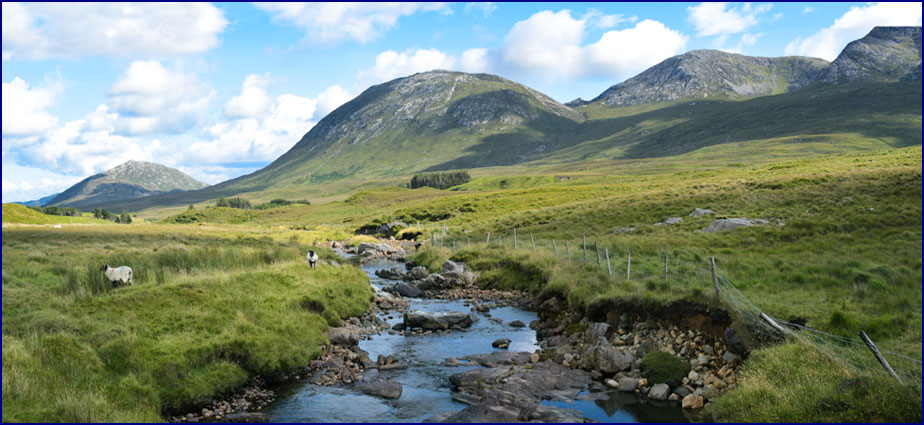
In the Maam Valley
|
Presently we left wild Connemara and
headed south past Galway, crossing more typical Irish countryside.
The fields and
farmland were lined with stone walls.
Around six in the evening we came to Ross Abbey, a
well-preserved ruin sitting in the middle of a cow field.
We spent a contented hour wandering through it.
We
drove on south, past the towns of Kilcolgan and Gort, enjoying the
beautiful rolling countryside.
It was getting dark by the time we got to our B&B for
the night (we had called ahead), the Lakeside Country Lodge near
Ennis. We had Happy
Hour on the patio, looking down across the pastures to Lough
Killone at the bottom of the hill, and the stone ruins of Killone
Abbey on the far shore.
Friday August 10
We got an early start in the morning because we were headed
down to the Millstreet Horse Show, in County Cork. Over
breakfast we learned that the couple who run the B&B had a
Connemara pony jumping at Millstreet that afternoon, in the
Ďthree-year-olds lungeing over fencesí class.
But we
couldnít get on the road without first checking out the Killone
Abbey! Although it was
just across the lake from the B&B, we had to drive several
miles down back roads to reach the entrance.
We parked by a gateway and walked up a small lane for about
fifteen minutes to the abbey, and we had the place totally to
ourselves. It was
lovely, with a cemetery on three sides, and dungeons in the lowest
level. We climbed the
stairs and walked out on the parapet, and looked down over the
grounds. The hill
stretched up to rolling farmland, and a swan with four cygnets
floated on the lough below. We
decided this was our best abbey to date.
|
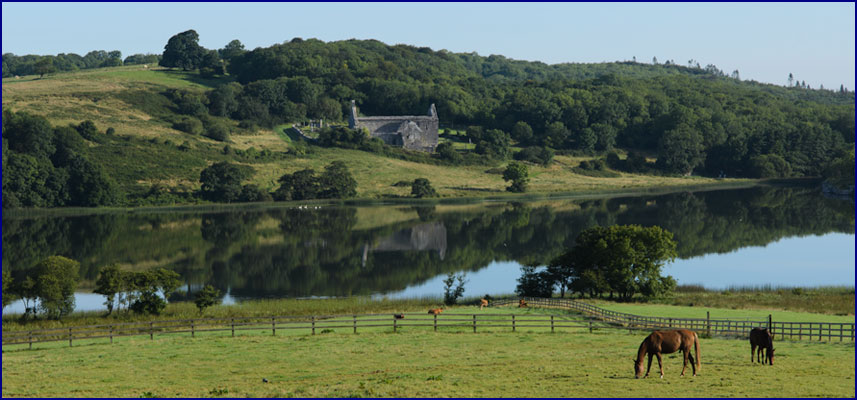
Killone Abbey
|
Walking back up the lane to our car
we passed a cave-like hole in the bank among the trees, well
covered in moss and ivy Ė surely this must be a fairy hole.
We kept a close eye out for leprechauns but saw none.
Back in the car, we found a shortcut out to the main road,
and soon we were heading south.
On
past trips to Ireland we had always, without fail, gotten lost in
the city of Limerick. No
matter how hard we tried to follow the signposts through town we
would end up taking convoluted routes on numerous side streets.
But since we had visited last they had built a bypass, so
now navigating past Limerick was a breeze.
The
Millstreet Horse Show was amazing.
We parked in a grassy field near the stables and toured the
showground; there were at least eight arenas going at once.
The majority of the classes seemed to be jumpers, but we
also saw kids on ponies, three and four year olds being
loose-schooled over fences, and young horses lungeing over jumps.
We wandered from one ring to another, and saw a number of
people we knew from horse-shopping.
In the
afternoon we watched the Grand Prix Jumper class in the main
arena. It was quite
well contested, with quite a few riders from England and Europe
having come over to compete at Millstreet and the Dublin Horse
Show the following week.
|
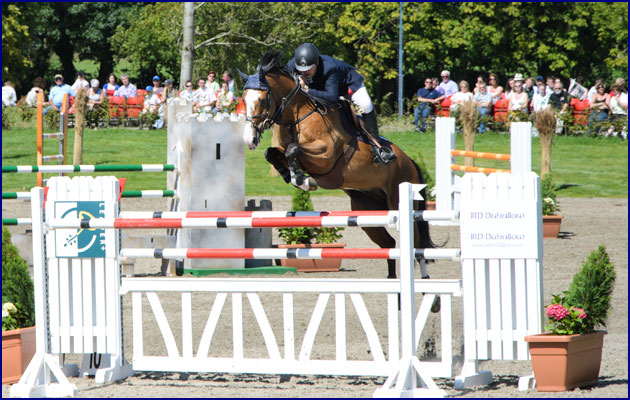
Jumping at Millstreet
|
We had arranged to visit a friend of
ours, Robin Blackmore, from whom I had bought several horses from
in the past, including Star Bright and Drifter.
Robin lives about two hours from Millstreet, so we needed
to leave the show by mid-afternoon.
When we went out to the car park, we found to our dismay
that our car was totally blocked in by other vehicles.
Repeated announcements of the offending license plates
yielded no results, but one of the cars behind us had a phone
number on it. When we
called the driver and he came to move the vehicle, it turned out
he was the trainer who would be longeing the pony over fences for
the owners of the B&B where we had stayed the night before.
Small world! We
finally got on the road, but more than an hour late.
We drove
northeast past Cashel, and on to the town of Killenaule.
The directions Robin had given us said that we would pass a
graveyard on the left and a small well on the right, and then we
would turn into the next gateway.
But it turned out that the graveyard was hidden behind a
stone wall, and the small well wasnít really a well after all,
so already running late, we missed the turning.
Eventually we found the right driveway, after Robin stood
in the road and flagged us down.
Robin
had arranged for us to have a tour of Kilcooley Abbey.
He drove us down a private lane through the thousand-acre
Kilcooley Estate; it is an impressive property, but unfortunately
the large manor house and stable block are now unoccupied and
falling into disrepair. A
twelve foot high stone wall surrounds the property; Robin called
it a Famine Wall, built by laborers in return for food during the
great famine in the mid-1800s.
|
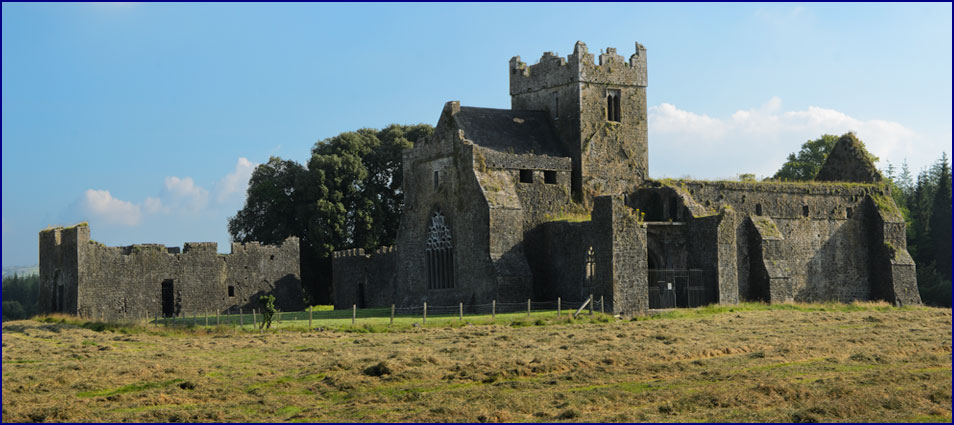
Kilcooley Abbey
|
Robin introduced us to Liam Noonan, a
local historian who acts as a caretaker of sorts for the Kilcooley
Estate and Abbey, and he gave us a fabulous private tour.
We walked across a newly cut hayfield to the abbey,
magnificent in the slanting rays of evening sunshine.
The walls are of thick stone, with grass growing on top of
them where the roof once was.
One side is adorned with gracefully arched windows with
intricate patterns fashioned in cement, long devoid of glass.
There is no cemetery, but a smooth green lawn surrounds the
ancient building, and a grove of mature hardwood trees stands
behind it.
Liam was a wealth of information,
giving us the history of the abbey and the surrounding areas.
He told us some of the history of the Butlers, the Barkers
and the Ponsonbys, the families who have owned the estate.
The abbey is nearly nine hundred years old; it was built
over three hundred years before Columbus discovered America.
Though technically open to the public, few people know
about the abbey and hardly anyone goes there, and it would be
quite difficult to find it on your own.
We entered through the arched doors of
the front entrance. The
original structure of the abbey dates back to 1186.
We went from room to room, with Liam telling us the details
about every arch and stone carving.
He could tell in what era each was crafted by its style and
masonís marks. In
the main hall near the entrance there are several intricately
carved tombs and a large stone altar.
One of the tombs in particular is very grand, with a
detailed replica of the occupant carved in stone on the lid; Liam
told us that it is the tomb of one of the Butlers, and it dates
from around 1467. He
noted that the face is gone, probably long since removed by
enemies of the Butlers. The
carving of the occupantís hands on the sword and the chain mail
armor is finely detailed. A
dog lies at his feet, signifying loyalty.
Liam said that a dog sleeping peacefully means the person
died in peace, but if its teeth are bared it means the person was
poisoned.
|

Liam and Robin at Kilcooley Abbey
|
Figures carved
around the side of the tomb represent ten of the twelve apostles,
and Liam could name them all and identify the significance of what
each was holding. (We
didnít find out what happened to the other two.)
He pointed out that the lettering on the coffin is raised
rather than recessed, which was a much more time-consuming and
expensive process to create. It
would have taken something like 500 man hours to carve out around
the letters, and few families could have afforded to have it done.
The high arched ceilings are of graceful
design. There are
little cubbyholes in the thick walls with recessed seats for the
abbots, and a sacristy room behind the altar where they would
prepare for services. There
are many stone carvings on the walls and archways, and Liam could
read the Latin inscriptions and interpret their meaning.
There is a depiction of St. Christopher, and of a pike
eating an eel. A
mermaid graces one wall, a mirror in one hand and a comb in the
other, with two fishes beside her.
Liam expounded on the theories of what each of these
symbols represented. Many
of the sculptures and ornate arches bear a masonís mark, a
little flower or design inscribed in the stone to identify the
mason who created it.
Liamís detailed knowledge of the
abbey was amazing. Whenever
we asked him a question, he would say ďand thatís another
storyĒ, and then launch into a detailed narrative.
He talked for hours, and we were mesmerized.
I wish I could have recorded all of the rich history he
recounted to us.
We walked around to the back of the abbey to the living
quarters. The abbey
would have been home to about twenty monks, and maybe another
twenty laypersons. Part
of the abbey was used as an infirmary, especially during the
cholera epidemic, and it also served as a nursing home for elderly
people to live out their days.
A huge ancient yew tree stands in a grassy courtyard; Liam
told us that yews, with their poisonous properties, were often
planted in churchyards and cemeteries to keep wild boars from
digging up the graves. We
saw no visible cemetery at the Kilcooley Abbey, but it seems
likely that there could be mortal remains somewhere deep beneath
that green lawn.
Across
the field from the abbey is a dovecote, a small round building of
stone used to house pigeons and doves.
Inside, the rough stone walls have indentions for the birds
to nest, and a circular hole in the top for them to fly in and out
of. The pigeons would
have been used as messengers, and also perhaps for food.
It
was an amazing opportunity to have a private tour of this
beautiful abbey with Liam. As
we walked back across the field, with the newly cut hay lying in
windrows, Liam noted that the swallows were flying high over the
castle, portending fine weather for haymaking.
He told us that when the swallows fly low over the fields,
bad weather is coming. At
first we thought this was superstition, but Liam explained that
the changes in barometric pressure influence the altitude at which
the insects fly, and the birds follow them.
For some reason this had seemed to be
our trip for visiting abbeys.
Just that morning we had been checking out the Killone
Abbey across the lough from our B&B and thinking it was the
best one we had seen, but our visit to Kilcooley surpassed it by
far. We said goodbye
to Liam, and then Robin drove us by the Kilcooley estateís manor
house and stable block. Both
are relatively new compared to the abbey, having been built in the
1800s, but are sadly falling into a state of neglect.
Robin said the entire thousand acre estate was being
offered for sale, but it would cost so much to restore it to good
condition that nobody could afford to buy it.
We
returned to Robinís farm, and he took us to see a fairy fort.
The sun was setting as we walked across the pasture to a
circular grove of trees, surrounded by a deep moat-like trench and
bordered by a thicket of blackthorn bushes. Robin
explained that this remnant of an ancient ringfort was built by
the people who inhabited Ireland during the Iron Age.
Commonly known as fairy forts, these artifacts left behind
by Irelandís earliest inhabitants are scattered across the
country.
We crossed
the ten foot deep, steep-sided trench and entered the dense copse.
It was quite dark under the trees, and we could just dimly
make out the remains of several age-old circular huts of mud and
stone. Robin told us
that at night the people would have brought the livestock down
into the surrounding trench, and then blocked the opening with
thorn bushes. The
entrances are usually on the south side, but nobody knows why.
Tradition
claims that these ancient dwellings were imbued with Druids'
magic, and those who believe in fairies will not alter them.
Many local people believe that to remove anything from
these forts or to cut any trees in them will cause bad luck or a
curse. I had just
picked up a stone to add to my collection of souvenirs when Robin
told us this - I hastily put it back.
|
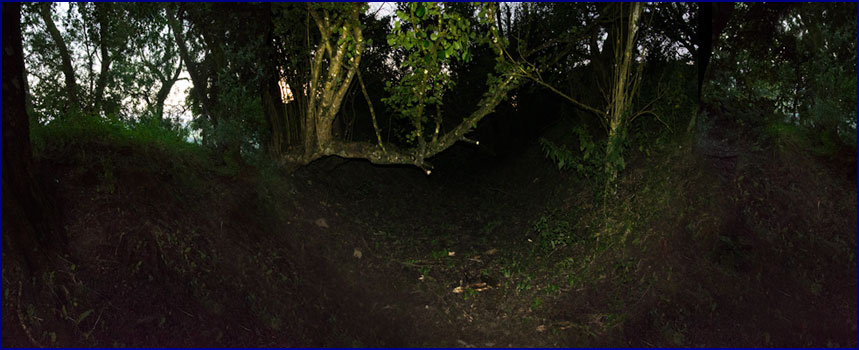
The Fairy Fort at dusk!
|
Robin said that when he was a child
his father used to run a hunter pace event across their farm.
One year he routed the course through the ring fort, and
cut some branches to clear the trail.
The old farmhand who worked for him predicted that
something bad would come of it, and sure enough, a week later
Robinís father had a bad fall and broke his leg.
The farmhand insisted it was because of a curse brought on
by disturbing the fairy fort.
Robin told
us that his son had done a school project about the fairy fort,
putting together an exhibit with photos and information, and he
had taken a rock from the fort as part of the display.
After his presentation the teacher had asked if the school
could keep the rock for a permanent exhibition; Robinís son said
ĎNo way,í and made sure to replace the stone exactly where he
had found it.
We
werenít sure if fairies and leprechauns inhabited this Iron Age
fort, or if the curses were real, but the place certainly felt
magical.
We
returned to Robinís house, quite a bit later than planned, and
his wife treated us to a fabulous lamb dinner.
It had been a spectacular afternoon.
We ended up being close to midnight getting to The Castle,
our lodging for the night. It
is a grand old manor house that has been converted to a B&B,
with very fancy rooms appointed with rich brocade bedspreads and
drapes. We felt like
royalty, though the place seemed just a little eerie.
The house is attached to an old castle keep in back, but we
were not allowed to go into it.
We slept soundly, dreaming of fairies no doubt.
|